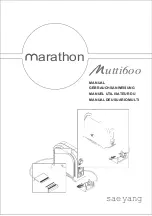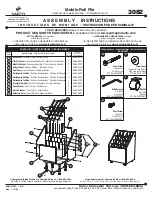
Section BXM‐10N‐HE5‐20A
030‐101815 Rev. A
R
12
1402IARA
Figure 16. Euro‐Connectors for Field‐Connections
Pull off
connectors
Strip wires 1/4”
then insert
wires here
1.
2.
Tighten screws to
secure wires
Connect to field‐
provided alarm
reporting equipment
Factory Prewired
Fan Connections
Field Connections for Power
Euro Connector
3.
Field Connections for Alarms
Pull off
connector
1.
Strip wires 1/4”
then insert
wires here
2.
Tighten screws to
secure wires
3.
Euro Connector
Factory
Prewired
POWER
ALARMS
Fan test
button
power wire to the ‐V terminal.
Connect the positive power wire:
Connect the positive
+24VDC power wire to the +V terminal.
S
-48VDC operation.
Connect the negative power wire:
Connect the ‐48VDC
power wire to the ‐V terminal.
Connect the positive power wire:
Connect the positive
power wire to the +V terminal.
8.
Re‐install Euro‐connector.
After the power wires are
properly positioned and secured in the Euro‐connector,
re‐insert the fan power 2‐pin Euro‐connector back into its
receptacle in the lower left corner of the controller card.
9.
Perform wire management.
Perform cable management
per company practice.
10.
Proceed to Paragraph 3.10.
Proceed to Paragraph 3.10 for
system power‐up.
3.9
Optionally Connecting External AC Power
For customer convenience, a knock‐out for AC power is pro
vided on the interior floor of the cabinet near the rear right
corner (see Figure 17). Use external 120 VAC power source to
power any equipment that will be installed in the Boxer cabinet,
per company practice. A co‐located pedestal with common ac
cess to Boxer shall be used to deliver AC power. The pedestal
shall contain a distribution panel, 20 amp circuit breaker, and
gapless suppressors. The pedestal shall be capable of accepting
120/240 volts, single phase, and provide hardware for mounting
a power meter. However, Boxer must only be supplied with 120
volts.
Follow the steps below to connect an external 120 VAC power
source to the Boxer cabinet.
All components in the pedestal must
be listed by a Nationally Recognized Testing Laboratory (NRTL),
all company practices, local codes, and National Electric Codes
must be followed, and only a qualified electrician should perform the
AC electrical installation.
Figure 17. Bottom Isometric View Showing Knock‐outs for
Power Cables/Wiring
Lower Right Rear Corner
of Boxer Cabinet
This knock‐out typically
used as access for op
tional battery cable (when
used with a battery box)
or for Network cables
This knock‐out typically
for optional AC power
cable
1.
Verify the power source.
Verify the power source is in good
working condition.
2.
Remove or disable power.
Disable the power at the power
source before proceeding (power is re‐applied in Para
graph 3.10).
3.
Verify the knock‐outs are removed.
Perform the steps in
Paragraph 3.5 to remove any appropriate cabinet hole
knock‐out(s), and to install an appropriate fitting or grom
met in the knock‐out hole (if needed).
4.
Install conduit.
Install all required fittings/conduit from
the power source to the hole on the bottom of the cabinet.
5.
Fish or route wires.
Fish or route the AC wires from the
power source through the conduit and into the Boxer cabi
net.
6.
Make the AC electrical wire connections.
Perform the elec
trical wire connections.
7.
Perform housekeeping.
Perform any needed wire manage
ment, per company practice, the NEC, and local codes.
8.
Proceed to Paragraph 3.10.
Proceed to Paragraph 3.10 for
system power‐up.
‐ WARNING ‐
All cabinet AC/DC power wiring, cabling, and installation
methods, both externally to the cabinet and installation and
wiring of internal cabinet equipment, must be performed by a
qualified electrician in accordance with the National Electri
cal Code (NEC) rules and local codes and practices.
3.10
Performing System Power‐Up
Before mounting any field‐provided communications equip
ment in the cabinet, verify all internal Boxer equipment and
power connections are functional. Follow the steps below to
perform a Boxer system power‐up procedure.
1.
Verify all power and ground connections are complete.
Ex
amine the earth ground and all power connections inside







































